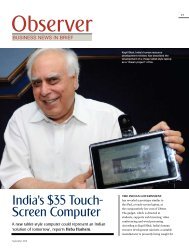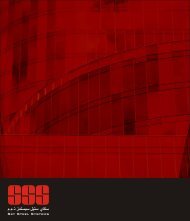Abu DhAbi ClAssiCs sCulpture symposium heritAge ... - Heba Hashem
Abu DhAbi ClAssiCs sCulpture symposium heritAge ... - Heba Hashem
Abu DhAbi ClAssiCs sCulpture symposium heritAge ... - Heba Hashem
- No tags were found...
Create successful ePaper yourself
Turn your PDF publications into a flip-book with our unique Google optimized e-Paper software.
8 latest<br />
Arab urban insights:<br />
reflecting on the Disorientation II<br />
If Disorientation was a man, he would<br />
be exuding non-conformism, realism<br />
and to some, maybe pessimism.<br />
Unlike other exhibitions that<br />
shed light on the greener side of<br />
things, with pleasing inspirational<br />
artwork, Disorientation has taken an<br />
independent path and chooses not<br />
to stop and wonder what will people<br />
think, but to present the reality as it<br />
is. An exhibition that can be classified<br />
as an artistic movement, it boldly<br />
addresses extremely sensitive historical<br />
and political issues that have become<br />
neglected over the decades.<br />
Disorientation II: The Rise and Fall of<br />
Arab Cities was the first exhibition to be<br />
held at <strong>Abu</strong> Dhabi’s new cultural venue,<br />
Manarat Al Saadiyat, where it showed<br />
for nearly four months. The curator<br />
of the exhibition was Jack Persekian,<br />
Sharjah Biennial’s Artistic Director.<br />
The artists in Disorientation<br />
convey sad truths and hypocrisies that<br />
lie within Arab nations by using the art<br />
of silence – through thought-provoking<br />
objects that overflow with meanings<br />
and messages. Images, sketchbooks,<br />
drawings, and monument replications<br />
take us through a startling journey,<br />
commencing with the utopian period<br />
of the sixties and seventies marked by<br />
the optimistic views of former Egyptian<br />
president Jamal Abdel-Nasser, whose<br />
era had promised unachieved hopes of<br />
unity between Arab nations.<br />
In the first edition of Disorientation,<br />
held in 2003 at Berlin’s House of<br />
World Culture, contemporary artists<br />
from the Middle East portray the<br />
Arab dissatisfaction through elaborate<br />
visuals. In Disorientation II, the focus<br />
extends to define two significant eras<br />
of the Arab world.<br />
This begins with Hala Elkoussy’s<br />
“On red nails, palm trees and other<br />
icons”, a collection displayed within an<br />
intimate room brimming with hundreds<br />
of images, video screens, side lamps,<br />
and chairs, all reminiscent of a period<br />
dating to half a century ago.<br />
One cannot help the rush of<br />
nostalgia, reminding us of a time when<br />
there was a hope for salvation from<br />
occupation and western domination.<br />
On one side of the room, newspaper<br />
clippings hang, showing Che Guevara<br />
posing for a picture with farmers.<br />
The artist points to a time when such<br />
legendary figures would visit the<br />
villagers and farmers in Egypt, not only<br />
the city of Cairo as the case is today.<br />
Moving from an insider’s view of<br />
Cairo to an outsider’s perspective, we<br />
meet the disoriented works of Ali Jabri.<br />
The Jordanian homosexual artist was<br />
infamously murdered in 2002 at his<br />
hometown apartment by a killer who<br />
was never identified (although the main<br />
suspect remains his Egyptian lover).<br />
Jabri’s philosophical work is based<br />
on values of unity and selflessness. He<br />
is also known for his anthropologist<br />
views displayed in the sketches and<br />
drawings of Cairo’s harsh streets,<br />
which he had called City Kitsch. In<br />
the eighties, however, Jabri’s work<br />
witnessed a major shift. Driven by<br />
shock and disappointment over the<br />
series of wars in the eighties and twofacedness<br />
of leaders, his collages from<br />
this period illustrate the disjointed lives<br />
and agonies of the time.<br />
The end of this era comes with Wael<br />
Shwaky’s Telematch Sadat. This piece is<br />
based on the famous German television<br />
competition “Telematch”, broadcasted<br />
in the seventies and eighties, which had<br />
teams from different German towns<br />
play games in costumes.<br />
In Telematch Sadat, village<br />
children re-enact Anwar Al Sadat’s<br />
1981 assassination, a point that<br />
symbolized the end of a period that<br />
defined Egypt as a leading force in the<br />
Arab world. Two years prior to that,<br />
Egypt had been suspended from the<br />
League of Arab States when Anwar Al<br />
Sadat signed the Camp David Peace<br />
Accords with Israel. More importantly,<br />
the following decades saw more wars,<br />
losses, displacement, bloodshed and<br />
instability than ever before. From the<br />
Iran-Iraq war and Lebanon’s invasion<br />
by Israel, to the Sabra and Shatila<br />
massacres, Arab nations were being<br />
torn apart and thousands of innocent<br />
lives were being lost.<br />
Monument replicas largely<br />
contribute to the portrayal of this<br />
chaotic division. Marwan Rechmaoui’s<br />
Beirut Caoutchouc is a map made of<br />
thick, flattened rubber etched to divide<br />
60 pieces, not to merely delineate<br />
different neighbourhoods of Beirut,<br />
but to penetrate into the history of the<br />
socio-political and economic causes<br />
of shifting through this complex<br />
urban cartography.<br />
Rechmaoui’s second work is<br />
portrayed in a three-dimensional<br />
human-sized model of Burj Al Murr, a<br />
skyscraper that still stands today. The<br />
tower, initially built for commercial<br />
purposes, was used by militia factions<br />
during the civil war in Lebanon as a<br />
sniper’s next, a prison and a place for<br />
captured hostages.<br />
Too high to knock down and<br />
too dense to implode, Burj Al Murr<br />
today is left neglected and unused.<br />
The monument has been called “the<br />
tower of death” and is living reminder<br />
of and witness to the tragic events that<br />
occurred in Lebanon.<br />
The story of Sabra and Shatila<br />
camps is represented through Monika<br />
Borgmann’s film Massaker – a personal<br />
initiative which led to the recording of<br />
narrated confessions from six people<br />
who participated in the massacre in<br />
these refugee camps.<br />
Toy-cars make up Yto Barrada’s<br />
satiric model Gran Royal Turismo. In<br />
a shabby Moroccan town three black<br />
Mercedes cars obviously carrying<br />
diplomats pass along the track; as<br />
they do, dirty buildings magically turn<br />
into pristine, palm trees suddenly pop<br />
out, and the sidewalks flip to reveal<br />
fresh paint and clean surfaces dotted<br />
with flags.<br />
This instant cleanup disguises the<br />
appalling living conditions that some<br />
authorities use when the only country’s<br />
leader, the one person with the power<br />
to effect change, visits a poor area of<br />
the town.<br />
Other bold pieces have reflected<br />
on similar issues and gaps within the<br />
Arab world, but there is one notion<br />
that Disorientation II seems to follow<br />
– the repetition of familiar failings,<br />
wasted opportunities and aggressive<br />
power struggles that leave behind bitter<br />
and divided societies. It is yet for us<br />
to witness an end to this era, which is<br />
currently intoxicated by injustices and<br />
discrimination, hopefully be replaced<br />
with higher morals, ethics and value.<br />
March 2010






